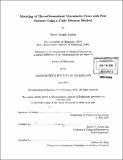| dc.contributor.advisor | Robert C. Armstrong. | en_US |
| dc.contributor.author | Adrian, David Joseph | en_US |
| dc.contributor.other | Massachusetts Institute of Technology. Dept. of Chemical Engineering. | en_US |
| dc.date.accessioned | 2010-11-08T17:38:26Z | |
| dc.date.available | 2010-11-08T17:38:26Z | |
| dc.date.copyright | 2010 | en_US |
| dc.date.issued | 2010 | en_US |
| dc.identifier.uri | http://hdl.handle.net/1721.1/59871 | |
| dc.description | Thesis (Ph. D.)--Massachusetts Institute of Technology, Dept. of Chemical Engineering, 2010. | en_US |
| dc.description | Cataloged from PDF version of thesis. | en_US |
| dc.description | Includes bibliographical references (p. 269-275). | en_US |
| dc.description.abstract | A framework and code have been developed to simulate fiber and film processes; the code can handle three-dimensional, isothermal, incompressible, creeping flow of a Giesekus fluid with free surfaces at infinite capillary number. The code is an extension of the parallel methods developed by Caola et al. from two- to three-dimensional flows, a restructured and improved version of the three-dimensional code of Phillips based on the subproblem formulation. The free surface motion used is an extension of the axially-constrained finite difference method of Phillips from two to three dimensions; internal domain deformation is upgraded from an elliptic mapping technique, only suitable for two-dimensional geometries, to the treatment of the domain as a fictitious elastic solid that conforms to the free surface, similar to the methods of Cairncross et al. The verification of the code and its utility are tested against the ability to capture experimental behavior in a set of benchmark problems which benefit from its ability to compute fully three-dimensional flow fields. Fluids with a nonzero second normal stress difference in simple shear flow, such as Giesekus fluids, exhibit secondary flows in non-circular, non-annular pipes. The code predicts the fully-developed three-dimensional velocity field in flow of a square duct in agreement with Yue et al. Elastically-driven flow transitions from a two-dimensional, steady flow to a three-dimensional, time periodic flow also motivate the need for three-dimensional solvers, which should be able to capture the onset directly. Flow around a closely-spaced linear periodic array of cylinders in a rectangular channel, a flow studied experimentally by Liu, exhibits this kind of flow transition. Numerical simulations have been conducted in this geometry with the Oldroyd-B model, [beta] = 0.67, wall separation distances between 4-32 radii, and Deborah number 0.1 < De < 2.0. The range of bounding wall edge effects on the flow field is shown to be just under 4 cylinder radii. At De = 2.0, the simulation shows small-magnitude oscillations after coming nearly to steady state, and a small-magnitude overshoot in the primary velocity component near the wall can be observed, similar to the "cat's ears" phenomenon observed by Poole et al. in planar gradual-contraction expansion flow of a viscoelastic fluid. The expected critical Weissenberg number of the flow transition has not yet been reached, but the previous limitation of Phillips at De = 0.7 in fully 3-D simulations of this geometry has been surpassed by over a factor of two and it is yet unknown what limiting De the code can reach with continuation methods. The free surface capability of the code is tested in free extrusion from cylindrical and elliptical dies. The code predicts the correct free surface shape and extrudate swell found in incompressible, inertialess Newtonian free jets from cylindrical capillaries. Extruded elliptical jets of Newtonian fluids (2:1 and 3:2 aspect ratios) were found to increase in area to the same extent as cylindrical jets, showing asymmetric swell to a more circular shape (1.8:1 and 2.8:2 final aspect ratios). When Oldroyd-B or Giesekus fluid jets are simulated, the extrudate swell computed increases greatly as Deborah number or polymer viscosity fraction increases, but the final aspect ratio appears to be insensitive to these parameters (De < 1.0). The total amount of swell (area ratio) appears to be independent of the die shape for the elliptical shapes considered (De < 1.0). In addition to solutions to benchmark problems, this thesis introduces the practice of Lagrangian and discontinuous Galerkin finite element methods used to solve various partial differential equations in three dimensions, including bookkeeping conventions that facilitate the development of parallel and modular solvers. Two discontinuous basis function types, discontinuous linear and mean-slope basis functions (abbreviated DLDG and MSDG), are compared in a three-dimensional linear advection problem; both methods show equivalent (quadratically convergent) accuracy in flows orthogonal to the element surfaces. While the DGMS method runs about twice as fast, the DGDL method has roughly twice the accuracy when flow is not orthogonal to element surfaces, so that the DGDL method is preferred whenever mesh refinement in more than one dimension is required to improve the accuracy. A parallel Poisson equation solver which uses PETSc is presented (the source code is available upon request) as a simple template which highlights the required structures needed in a parallel finite element code. | en_US |
| dc.description.statementofresponsibility | by David Joseph Adrian. | en_US |
| dc.format.extent | 275 p. | en_US |
| dc.language.iso | eng | en_US |
| dc.publisher | Massachusetts Institute of Technology | en_US |
| dc.rights | M.I.T. theses are protected by
copyright. They may be viewed from this source for any purpose, but
reproduction or distribution in any format is prohibited without written
permission. See provided URL for inquiries about permission. | en_US |
| dc.rights.uri | http://dspace.mit.edu/handle/1721.1/7582 | en_US |
| dc.subject | Chemical Engineering. | en_US |
| dc.title | Modeling of three-dimensional viscoelastic flows with free surfaces using a finite element method | en_US |
| dc.title.alternative | Modeling of 3-D viscoelastic flows with free surfaces using a finite element method | en_US |
| dc.type | Thesis | en_US |
| dc.description.degree | Ph.D. | en_US |
| dc.contributor.department | Massachusetts Institute of Technology. Department of Chemical Engineering | |
| dc.identifier.oclc | 672396223 | en_US |
